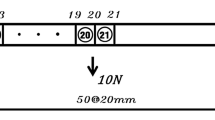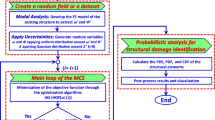Abstract
The probabilistic damage identification problem with uncertainty in the FE model parameters, external-excitations and measured acceleration responses is studied. The uncertainty in the system is concerned with normally distributed random variables with zero mean value and given covariance. Based on the theoretical model and the measured acceleration responses, the probabilistic structural models in undamaged and damaged states are obtained by two-stage model updating, and then the Probabilities of Damage Existence (PDE) of each element are calculated as the damage criterion. The influences of the location of sensors on the damage identification results are also discussed, where one of the optimal sensor placement techniques, the effective independence method, is used to choose the nodes for measurement. The damage identification results by different numbers of measured nodes and different damage criterions are compared in the numerical example.
Similar content being viewed by others
References
Ma, H.W. and Yang, G.T., Methods and advance of structural damage detection. Advances in Mechanics, 1999, 29(4): 513–527. (in Chinese)
Lim, T.W., Structural damage detection using constrained eigenstructure assignment. Journal of Guidance, Control and Dynamics, 1995, 18(3): 411–418.
Abo, M., Structural damage detection by natural frequencies. In: AIAA/ASME/ASCE/ AHS/ASC Structures, Structural Dynamics and Materials Conference and Exhibit, 37th. American Institute of Aeronautics and Astronautics Paper, Salt Lake City, 1996: 1064–1069.
Parloo, E., Guillaume, P. and Overmeire, M.V., Damage assessment using mode shape sensitivities. Mechanical Systems and Signal Processing, 2003, 17(3): 499–518.
Lee, U. and Shin, J., A structural damage identification method for plate structures. Engineering Structures, 2002, 24: 1177–1188.
Feng, X., Fing, Y.F. and Zhou, J., A flexibility-based method for damage localization of truss structures. Chinese Journal of Computational Mechianics, 2006, 23(5): 563–568.
Elishakoff, I., Three versions of the finite element method based on concepts of either stochasticity, fuzziness or anti-optimization. Applied Mechanics Reviews, 1998, 51(3): 209–218.
Papadopoulos, L. and Garcia, E., Structural damage identification: a probabilistic approach. AIAA Journal, 1998, 36(11): 2137–2144.
Xia, Y. and Hao, H., Statistical damage identification of structures with frequency changes. Journal of Sound and Vibration, 2003, 263: 853–870.
Li, X.Y. and Law, S.S., Damage identification of structures including system uncertainties and measurement noise. AIAA Journal, 2008, 46(1): 263–276.
Meo, M. and Zumpano, G., On the optimal sensor placement techniques for a bridge structure. Engineering Structures 2005, 27: 1488–1497.
Lu, Z.R. and Law, S.S., Features of dynamic response sensitivity and its application in damage detection. Journal of Sound and Vibration, 2007, 303(1–2): 305–329.
Kammer, D.C. and Brillhart, R.D., Optimal sensor placement for modal identification using system-realization methods. Journal of Guidance, Control and Dynamics, 1996, 19: 729–31.
Heo, G., Wang, M.L. and Satpathi, D., Optimal transducer placement for health monitoring of long span bridge. Soil Dynamics and Earthquake Engineering, 1997, 16: 495–502.
Imamovic, N., Model Validation of Large Finite Element Model Using Test Data. Ph.D. dissertation, Imperial College London, 1998.
Doebling, S.W., Measurement of structural flexibility matrices for experiments with incomplete reciprocity. Ph.D. dissertation, Colorado University, 1996.
Larson, C.B., Zimmerman, D.C. and Marek, E.L., A comparison of modal test planning techniques: excitation and sensor placement using the NASA8-bay truss. In: Proceedings of the 12th International Modal Analysis Conference, 1994, 205–211.
Author information
Authors and Affiliations
Corresponding author
Additional information
Project supported by the National Nature Science Foundation of China (No. 11372025), the Aeronautical Science Foundation of China (No. 2012ZA51010) and Defense Industrial Technology Development Program (Nos. A2120110001 and B2120110011).
Rights and permissions
About this article
Cite this article
Wang, X., Yang, C., Wang, L. et al. Probabilistic Damage Identification of Structures with Uncertainty Based on Dynamic Responses. Acta Mech. Solida Sin. 27, 172–180 (2014). https://doi.org/10.1016/S0894-9166(14)60027-6
Received:
Revised:
Published:
Issue Date:
DOI: https://doi.org/10.1016/S0894-9166(14)60027-6




